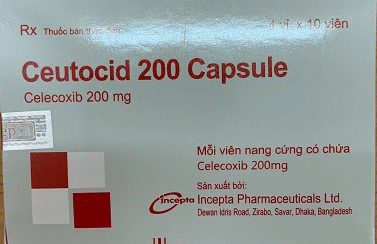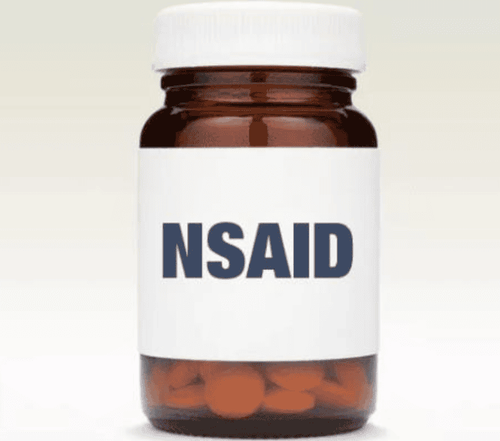This is an automatically translated article.
Aclopsa belongs to the group of pain relievers, non-steroidal anti-inflammatory drugs, drugs containing the active ingredient Aceclofenac, which have the predominant effect in the treatment of bone and joint diseases.
1. Effects of the drug Aclopsa
Aclopsa is a brand name containing the active ingredient Aceclofenac 100mg, the drug is prepared in the form of film-coated tablets. Aceclofenac is a selective COX-2 inhibitor non-steroidal anti-inflammatory drug (NSAID) with several advantages over classical NSAIDs.
Non-steroidal anti-inflammatory drugs (NSAIDs) are effective in treating symptoms of osteoarthritis diseases such as: rheumatoid arthritis, osteoarthritis, ankylosing spondylitis, ... or treating acute pain conditions. other. However, classical NSAIDs (COX-1 inhibitors) have the disadvantage that they can cause side effects on the gastrointestinal system such as peptic ulcers. COX-2 inhibitor NSAIDs such as the coxib tails (celecoxib, rofecoxib) are controversial, because of the increased risk of cardiovascular events.
Aceclofenac proves to be advantageous when it has strong analgesic and anti-inflammatory effects such as diclofenac, indomethacin; but Aceclofenac is safer than other NSAIDs as it causes less gastrointestinal and cardiovascular side effects thanks to selective COX-2 inhibition. Therefore, Aclopsa (Aceclofenac 100mg) is indicated in the following cases:
Pain relief, anti-inflammatory treatment in osteoarthritis diseases: osteoarthritis, rheumatoid arthritis, chronic arthritis, ankylosing spondylitis , ... thereby improving joint amplitude in patients with osteoarthritis of the knee, reducing morning stiffness in patients with rheumatoid arthritis, reducing morning stiffness and ease of spine mobility in patients with ankylosing spondylitis. joints,... Pain relief treatment for cases: toothache, back pain, pain due to injury,...
2. Pharmacodynamics and pharmacokinetics of Aclopsa (Aceclofenac)
2.1. Pharmacodynamics Non-steroidal anti-inflammatory drugs (NSAIDs) generally have analgesic and anti-inflammatory activity by inhibiting cyclooxygenase (COX), thereby preventing the production of prostaglandins - substances involved in the inflammatory response. Some NSAIDs inhibit lipooxygenase, leading to inhibition of leukotrienes. Aceclofenac is a phenylacetic derivative, with strong inhibitory effects on cyclooxygenase enzymes, interleukin-1 (IL-1) and tissue necrosis factor. Aceclofenac inhibits prostaglandin E2 (PGE2) formation by inhibiting cyclooxygenases COX-1 and COX-2 via the 4'-hydroxy metabolites aceclofenac and diclofenac in inflammatory joint cells as well as other inflammatory cells. . However, in vivo experiments showed that Aceclofenac selectively inhibits COX-2 than COX-1, IC50 COX-2: COX-1 ratio of Aceclofenac about 0.26, higher than Celecoxib, Rofecoxib, Nimesulide, Diclofenac , Tenoxicam. On the other hand, Aceclofenac also stimulates cartilage tissue synthesis by inhibiting interleukin-1 (IL-1). In vivo experiments, Aceclofenac stimulated glycosaminoglycan synthesis in cartilage of osteoarthritis patients and stimulated the synthesis of anti-IL-1 receptor in articular chondrocytes. In addition, the intermediate of Aceclofenac, 4'-hydroxy aceclofenac, protects cartilage through a number of other mechanisms.
2.2. Pharmacokinetics of the drug After taking Aclopsa, Aceclofenac is rapidly and completely absorbed from the gastrointestinal tract. Food can slow down the absorption of the drug, but does not affect the extent to which it is absorbed.
Peak blood concentrations of the drug are reached after 1-3 hours. The drug is strongly bound to plasma proteins. The major metabolite of Aceclofenac is 4'-hydroxy aceclofenac. In addition, there are other metabolites such as: 5-hydroxy aceclofenac, diclofenac, 4'-hydroxy diclofenac, 5-hydroxy diclofenac.
The drug is excreted mainly by the kidneys and excreted in the urine as glucuronides (70-80%), the rest is excreted in the feces.
3. Dosage, how to use Aclopsis
The drug Aclopsa is formulated in the form of film-coated tablets that should be taken orally. Dosage is as follows:
Adults: recommended to take 100 mg/time x 2 times/day, the times are to be taken every 12 hours. Elderly: No dose adjustment is required in elderly patients, as the pharmacokinetics of Aceclofenac are unchanged in this patient population. Patients with renal impairment: No dose adjustment is required.
4. Side effects of the drug Aclopsa
Most adverse effects of Aclopsa (Aceclofenac) are uncommon, if any, are mild and reversible. Patients taking Aclopsa may experience the following symptoms:
Digestive: Abdominal pain, nausea, indigestion, flatulence, constipation, gastritis, diarrhea,... Nervous: Dizziness, headache. Skin: Itching, rash, urticaria. Laboratory tests: Increased liver enzymes, blood creatinine.
5. Contraindications to use Aclopsis
Contraindicated to use Aclopsa in the following cases:
Contraindicated to use Aclopsa in cases of hypersensitivity to Aceclofenac or any other ingredient of the drug. Aceclofenac is also not contraindicated in people who are allergic to NSAIDs, aspirin with manifestations such as: acute rash, acute rhinitis, or the appearance of bronchial asthma, or other allergic symptoms.
6. Be careful when using Aclopsis
Caution when using Aclopsa drug in the following subjects:
Progressive gastric - duodenal ulcer, gastrointestinal bleeding - bowel, history of peptic ulcer. Severe liver failure. Heart failure. Moderate-severe renal failure. Taking diuretics. Recovering from surgery. Elderly. Alcoholism. Avoid taking the drug in children, pregnant and lactating women.
7. Drug interactions
Drug interactions that may occur during use are as follows:
Lithium, Digoxin, Methotrexate: Aceclofenac when combined with Lithium, Digoxin, Methotrexate increases the plasma concentration of these drugs. Anticoagulants: Aceclofenac increases the activity of anticoagulants. Diuretics: Aceclofenac inhibits the activity of Cyclosporin diuretics: Cyclosporin nephrotoxicity is increased when combined with Aceclofenac. Quinolone antibiotics: The combination of Aceclofenac with Quinolone antibiotics can make patients prone to convulsions. Other NSAIDs: Concomitant administration of Aceclofenac with other NSAIDs or corticosteroids may increase adverse events. Aclopsa belongs to the group of pain relievers, non-steroidal anti-inflammatory drugs, drugs containing the active ingredient Aceclofenac, which have the predominant effect in the treatment of bone and joint diseases. To ensure the effectiveness of treatment and avoid unwanted side effects, patients need to strictly follow the instructions of the doctor, professional pharmacist.
Follow Vinmec International General Hospital website to get more health, nutrition and beauty information to protect the health of yourself and your loved ones in your family.
Please dial HOTLINE for more information or register for an appointment HERE. Download MyVinmec app to make appointments faster and to manage your bookings easily.













